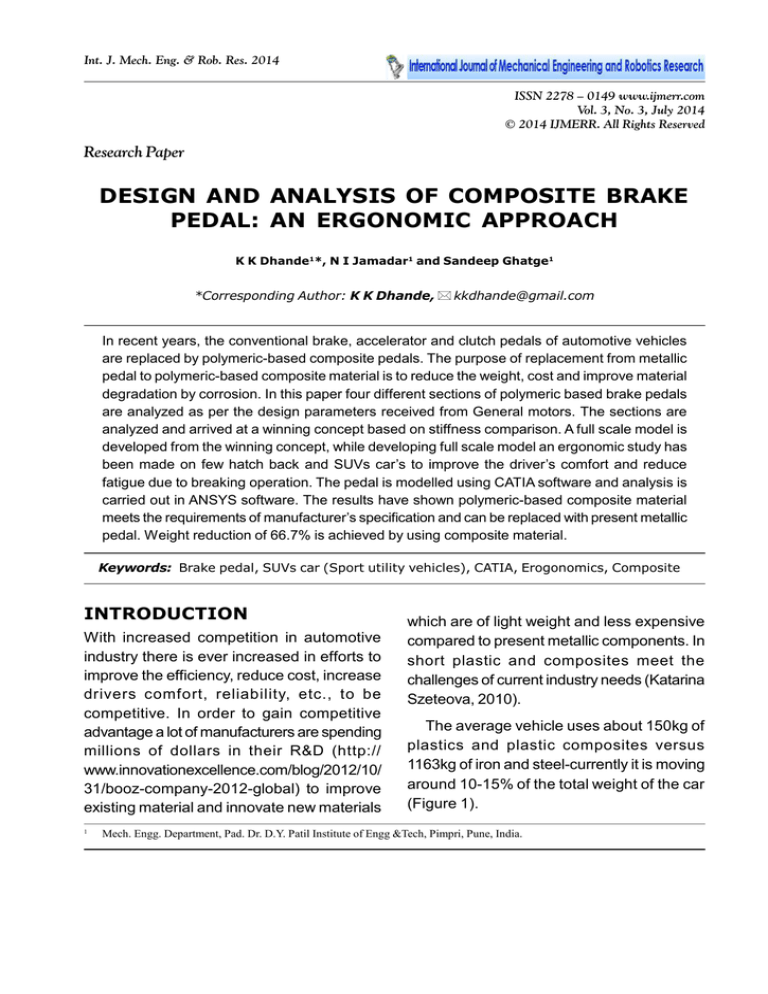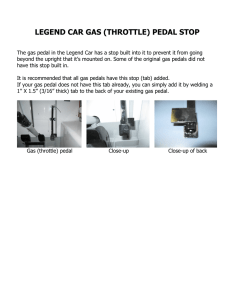
Int. J. Mech. Eng. & Rob. Res. 2014
K K Dhande et al., 2014
ISSN 2278 – 0149 www.ijmerr.com
Vol. 3, No. 3, July 2014
© 2014 IJMERR. All Rights Reserved
Research Paper
DESIGN AND ANALYSIS OF COMPOSITE BRAKE
PEDAL: AN ERGONOMIC APPROACH
K K Dhande1*, N I Jamadar1 and Sandeep Ghatge1
*Corresponding Author: K K Dhande, kkdhande@gmail.com
In recent years, the conventional brake, accelerator and clutch pedals of automotive vehicles
are replaced by polymeric-based composite pedals. The purpose of replacement from metallic
pedal to polymeric-based composite material is to reduce the weight, cost and improve material
degradation by corrosion. In this paper four different sections of polymeric based brake pedals
are analyzed as per the design parameters received from General motors. The sections are
analyzed and arrived at a winning concept based on stiffness comparison. A full scale model is
developed from the winning concept, while developing full scale model an ergonomic study has
been made on few hatch back and SUVs car’s to improve the driver’s comfort and reduce
fatigue due to breaking operation. The pedal is modelled using CATIA software and analysis is
carried out in ANSYS software. The results have shown polymeric-based composite material
meets the requirements of manufacturer’s specification and can be replaced with present metallic
pedal. Weight reduction of 66.7% is achieved by using composite material.
Keywords: Brake pedal, SUVs car (Sport utility vehicles), CATIA, Erogonomics, Composite
INTRODUCTION
which are of light weight and less expensive
compared to present metallic components. In
short plastic and composites meet the
challenges of current industry needs (Katarina
Szeteova, 2010).
With increased competition in automotive
industry there is ever increased in efforts to
improve the efficiency, reduce cost, increase
drivers comfort, reliability, etc., to be
competitive. In order to gain competitive
advantage a lot of manufacturers are spending
millions of dollars in their R&D (http://
www.innovationexcellence.com/blog/2012/10/
31/booz-company-2012-global) to improve
existing material and innovate new materials
1
The average vehicle uses about 150kg of
plastics and plastic composites versus
1163kg of iron and steel-currently it is moving
around 10-15% of the total weight of the car
(Figure 1).
Mech. Engg. Department, Pad. Dr. D.Y. Patil Institute of Engg &Tech, Pimpri, Pune, India.
474
Int. J. Mech. Eng. & Rob. Res. 2014
K K Dhande et al., 2014
As per Mohd Sapuan Salit et al. (2005)
there are polyamide (nylon) with short glass
fibers in varying percentages. The long glass
fibers are not suitable because of fiber
intermeshes and their corners may be
overlapped. Thus, from consideration of
material strength and stiffness. The short
glass fiber is lightest among materials, which
has lowest density. Nylon with short fiber has
high impact strength, which is an important
factor of brake pedal design. Considering %
elongation and other properties nylon with short
fibers is chosen as the material of brake pedal.
Figure 1: Increase Use of Plastic
in Automotive
Source: Atur Cichancki and Mateusz Wirwicki (xxxx)
Sapune (2005) and Pankaj Chhabra (2011)
worked on the brake pedal using polymeric
based material shows that the use of
composite material reduces weight and is
equally strong compared to metallic brake
pedal. Various concepts presented and
analyzed to arrive at the winning concept which
is optimized using Finite Element Analysis
(FEA) is well appreciated. There are other
papers which talked about use of composite
materials but all the papers lack in considering
drivers comfort and wellbeing. With the recent
rising customers’ expectations comfort has
become a critical quality requirement. This
gives vehicle design engineers a significant
challenge. Much of the work presented in this
paper considers both reducing weight and
increasing drivers comfort (ergonomic
aspects) considering the work done in the
past.
The material properties are shown in below
Table 1.
Table 1: Material Properties
(PA66 GF30%)
% Glass Filled
30%
Tensile Modulus
15000 MPa
Tensile Strength
160 MPa
Poisson Ratio
Flexural Modulus
Density
0.35
3300 Mpa
1130 Kg/m3
Moisture Absorption
0.35%
Creep Resistance
Good
Corrosion Resistance
Good
Chemical Resistance
Good strength heat
resistance
Ergonomic Considerations
MATERIAL SELECTION
This study emphasis on an integration of
ergonomics and composite material to reduce
weight and increase drivers comfort. As
mentioned, drivers comfort is prime concern
in design of accessories which are accessible
to driver. The ultimate aim of this study is to
understand the relationship between the
driver’s perception of comfort and the
engineering design attributes associated with
Following factors are considered for material
selection
1. Strength to weight ratio
2. Moldability
3. Physical and mechanical properties
4. Availability
475
Int. J. Mech. Eng. & Rob. Res. 2014
K K Dhande et al., 2014
brake pedal design. It is recognized that in
order to achieve this attention needs to focus
on two aspects.
Figure 2: Position of Brake Pedal
• Need to understand the relationship
between the drivers actual response, i.e.,
what the driver actually does in terms of
positioning, posture and adjustments to
posture, pattern and amplitude of
movements required to complete the driving
task and the driver’s perception of comfort,
i.e., the subjective response.
• Need to assess the relationship between
the pedal design and other relevant
engineering attributes(as inputs) and the
drivers actual perceived response.
Figure 3: Dimension of Driver Posture
Following are the ergonomic factor which
affects the driver’s comfort (Neil Dixon et al.,
2009).
• Subject anthropometrics (Leg segments,
foot length, stature, soft tissue).
• Driver positioning (Seat position force, seat
recline angle).
Figure 4: Vehicle Interior Points and Dimensions
Source: Vivek Bhise (xxxx)
476
Int. J. Mech. Eng. & Rob. Res. 2014
K K Dhande et al., 2014
All above data is collected from the different
vehicles running in the field (shown in Table 2).
Figures 3 and 4 shows various nomenclatures
related to driver and brake pedal.
• Driver movements (Hip, knee and ankle joint
angles)
• Contact surface interaction (buttocks on
seat, heel contact location on floor, contact
between the foot and pedals)
Conceptual Brake Pedal Lever Arm
Profile Design
• Longer term (i.e., over and extended drive
task)
The conceptual design of the polymeric-based
composite brake pedal concentrates on beam
for the design of the brake pedal lever. There
are four concepts of beam. The concepts of
the beam generated are shown in Figure 5.
The design parameters proposed by General
To understand the effect of the above
mentioned factors various seating parameters
are studied for the Sport Utility Vehicles (SUVs)
car.
Table 2: Vehicle Interior Dimensions
Hatch Back for 5 ft Female and 6 ft Male
Dim.
GM Beat
Tata ind-vista
Maruti Wagnor
Honda i20
Mean Value
Male
Female
Male
Female
Male
Female
Male
Female
Male
Female
C
810
715
820
615
800
708
830
680
815
680
D
140
170
160
180
140
170
130
160
160
170
E
240
240
250
250
260
260
310
310
265
265
F
470
420
480
410
485
410
510
460
490
425
G
890
760
860
740
890
720
895
730
880
735
H
470
460
530
460
588
450
592
510
545
400
J
420
380
430
380
430
390
450
380
450
380
K
280
238
440
360
460
370
480
370
380
334
R
680
450
700
480
680
530
650
480
670
490
Figure 5: The Different Beam Sections
Concept 1
Concept 2
Concept 3
477
Concept 4
Int. J. Mech. Eng. & Rob. Res. 2014
K K Dhande et al., 2014
Motors are listed in Table 3 (Mohd Sapuan
Salit et al., 2005).
Table 3: Requirement Static Load
(Maximum)
Requirement
Static Load
Force
Maximum
Deflection
Transverse Load
220 N
10 mm
Normal Force
1100 N
10 mm
Maximum Force
2700 N
15 mm
FEA Analysis of Conceptual Brake
Pedal Profile
The computational results of analytical and
FEA shown in Table 4 they are considered for
concept evaluation. Concept 1 chosen as
Source: Mohd Sapuan Salit et al. (2005)
Figure 6: Solid Models of Conceptual Design of Brake Pedal Arm
Cad model concept 1
Cad model concept 2
Cad model concept 3
Cad model concept 4
Figure 7: Total Deformation
Concept 1, Total deformation
Concept 2, Total deformation
478
Int. J. Mech. Eng. & Rob. Res. 2014
K K Dhande et al., 2014
Figure 7 (Cont.)
Concept 3, Total deformation
Concept 4, Total deformation
Figure 8: Equivalent Stress
Concept 1, Equivalent stress
Concept 2, Equivalent stress
Concept 3, Equivalent stress
Concept 4, Equivalent stress
Table 4: Total Deformation and Stress Calculated with Computed FEA Results
Calculated with Computed FEA Results for Different Concept with 220 N Traverse Load
Maximum Deflection “mm”
Maximum Stress (N/mm2)
Concept
Volume m2
Mass (Kg)
%Error
Analytical
FEA
% Error
1
58
103
2.36
2.27
9
22.9
23.0
10
2
63
109
1.13
1.3
8
13
14
8
3
32
54
0.98
6.3
15
9.478
10.9
9
4
47
80
3.97
4.04
10
28.18
53.6
10
Analytical
FEA
479
Int. J. Mech. Eng. & Rob. Res. 2014
K K Dhande et al., 2014
Table 5: Relative Mass, Volume, Deformation, Maximum Stresses are Compared
with Concept 1
Concept
Weight Ratio
Maximum Deflection Ratio
Maximum Stress Ratio
Concept 1
1
1
1
Concept 2
0.93
1.8
1.7
Concept 3
1.87
2.8
2.3
Concept 4
1.26
1.6
1.62
Table 6: Matrix Evaluation of the Beam Used to Select the Best Concept
Weight
No.
Criteria
Rating
Factor
Concept 2
Concept 3
Weight Factor X Rating
Concept 4 Concept 2 Concept 3 Concep 4
1
Wight
2
2
4
2
4
8
4
2
Maximum Deflection
3
3
1
2
9
3
6
3
Maximum stress
3
3
1
2
9
3
6
21
19
16
reference for high stiffness. Weight, volume,
maximum deflection. The corresponding values
for other concepts are calculated and
comparison to concept 1. A matrix evaluation
is performed to select the best concept among
Concept 2, Concept 3, Concept 4 based on
the results shown in Table 6. Each concept is
rated on the basis of reference score on scale
1 to 4. Weight factor decision matrix is
evaluated by multiplying the each concept rating
by weight factor assigned for each criterion
(Panakaj Chhabra, 2011). The total highest
score of 21. There for concept 2 chosen as best
profile for design of composite pedal.
Figure 9: Modeling of Complete I Section
Brake Pedal
Figure 10: Stress Distribution
Present Concept design and Prototyping of
composite accelerator pedal design was
selected I-section is the best Profile (Panakaj
Chhabra, 2011).
Final Design Brake Pedal (I-Section)
According to general motor specification
shown in Table 2 the maximum load of 2700 N
applied to pedal, deflection was observed 16
mm shown in Table 7.
480
Int. J. Mech. Eng. & Rob. Res. 2014
K K Dhande et al., 2014
Figure 11: Total Deflection
Table 7: Analytically and FEA Analysis Report for Composite Brake Pedal
Mass (g)
Final Results
219
Deformation (mm)
Volume (cm2)
Stress (N/mm2)
Analytical
FEA
Analytical
FEA
16.5
16
315
374.6
192.5
RESULTS AND DISCUSSION
• The design and analysis of composite
brake pedal weight is 0.219 kg compared
to metallic brake pedal weight 0.72 kg. The
total weight can be reduced by 66.7%.
• Various sections of brake pedals are
analyzed and result a show that the I section
is the stiffer among all the pedals under
study and hence I section is used for further
study.
CONCLUSION
A detailed analysis and study of the composite
brake pedal made from polyamide with short
glass fiber material is presented. Various
SUVs cars present in the market are studied
for the ergonomic aspects and the final model
is design based on the dimensions arrived
from this study. The results as discussed above
shows that there will significant cost saving
• The ergonomic parameters are used to
model the brake pedal using CATIA and
analyzed for the stated load conditions.
• The design is optimized using CATIA and
FEA to optimize the section and weight.
• The results show that the deflection and
stresses are within the requirements.
481
Int. J. Mech. Eng. & Rob. Res. 2014
K K Dhande et al., 2014
from the material and parameters selected for
this study.
Today”, from Institute of Production
Technologies, Machine Technologies and
Materials, Faculty of Material Science and
Technology in Tranava.
The actual prototype pedal needs to be
studied further for drivers comfort and fatigue
by putting it into actual work and compare with
the filed pedals.
6. Mohd Sapuan Salit, Mohad Syed Ali-Molla
and Liakot Ali M D (August 2005),
“Conceptual Design of an Automotive
Composite Brake Pedal”, University Putra
Malaysia 43400 Sedan Selangor
Malaysia.
REFERENCES
1. Atur Cichancki and Mateusz Wirwicki
(2010), “Erogonomics Analysis of AnthropTechnical Systems in the Environment of
Catia Program”, pp. 785-796, University
of Technology and Live Science
Bydgoszcz ul kaliskiego, Poland.
7. Neil Dixon, Sam Brook and Rob Freeman
(2009), “Ergonomic Data Measuring
System for Driver-Pedals Interaction”,
George Rosala and Felician Campean
University of Brad-Ford, SAE International,
UK.
2. Cameron D Cmmahon and Murray Scott
(2002), “Innovative Techniques for the
FEA Optimization of Composite
Structures”, Department of Aerospace
Engineering Royal Melbourne Institute of
Technology GPO Australai.
8. Panakaj Chhabra (2011), “Concurrent
Design and Prototyping of Composite
Acceletor Pedal”, University of Science
and Technology Hisar Haryana.
9. Sapune S M (2005), “A Conceptual
Design of Concurrent Engineering
Design System for the Polymeric Based
Composite Automotive Pedals”,
Department of Mechanical and
Manufacturing Engineering University
Putrs Malaysia.
3. Hossein Saidpour (2004), “Light-Weight
High Performance Materials for Car Body
Structures”, NTI Technology Conference,
Ford Motors Company.
4. http://www.innovationexcellence.com/
blog/2012/10/31/booz-company-2012global
10. Vivek D Bhise (2011), Erogonomics in
Automotive Design Process, CRC
Press.
5. Katarina Szeteova A (2010), “Automotive
Materials Plastics in Automotive Markets
482




